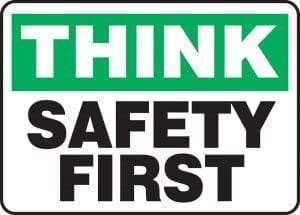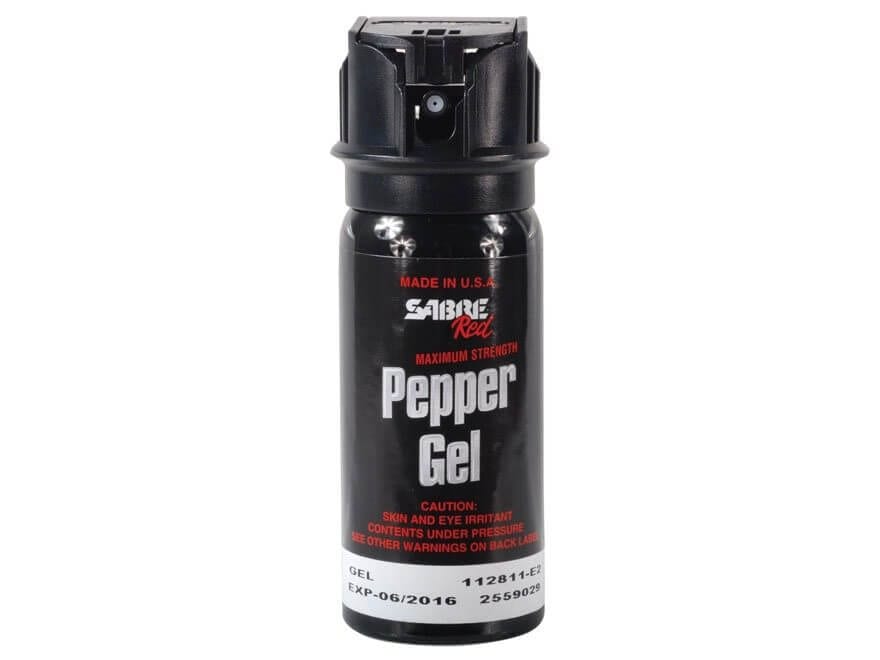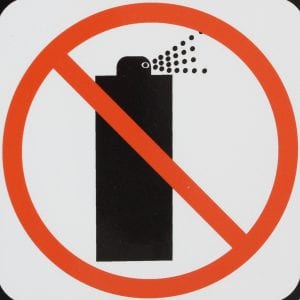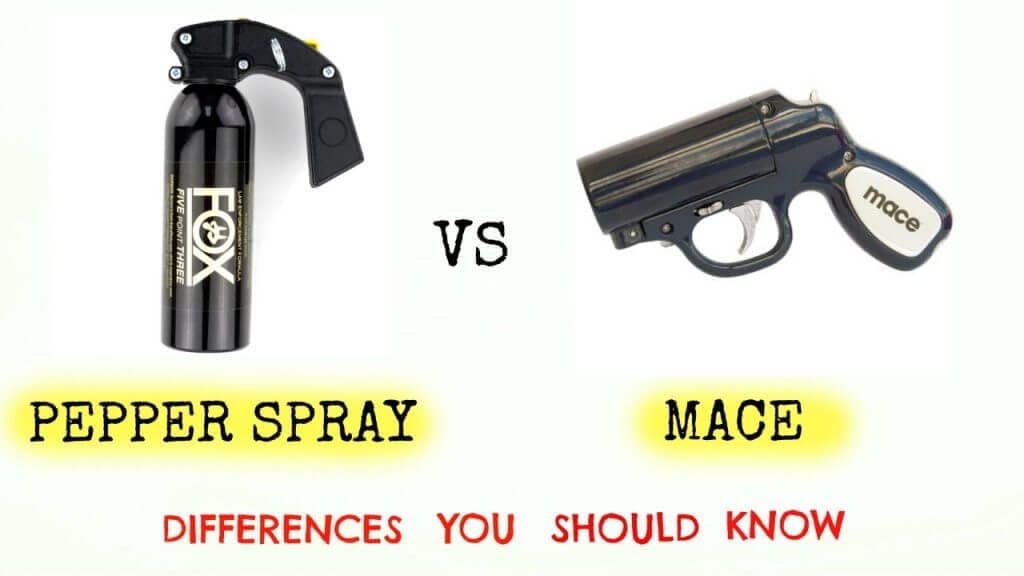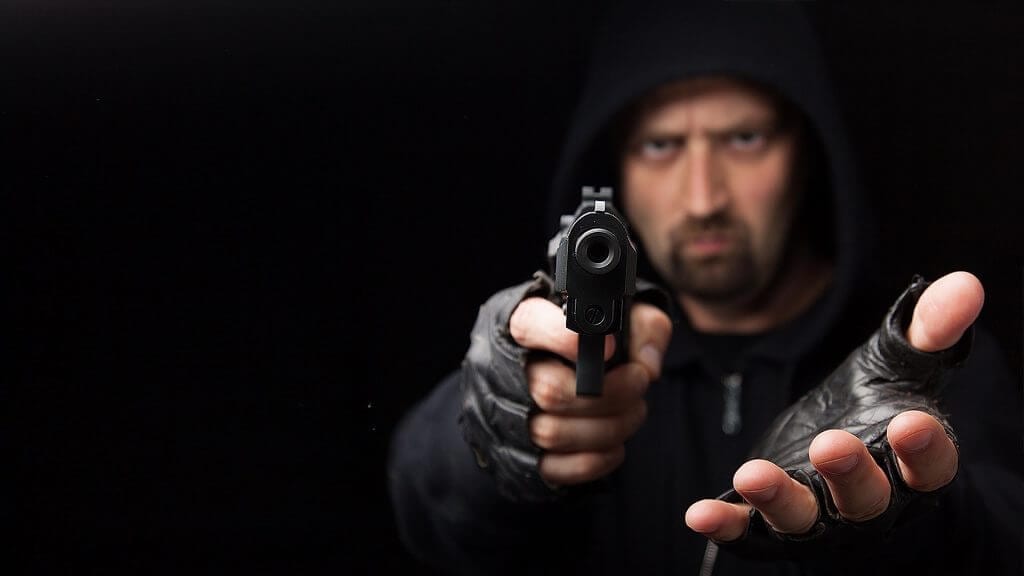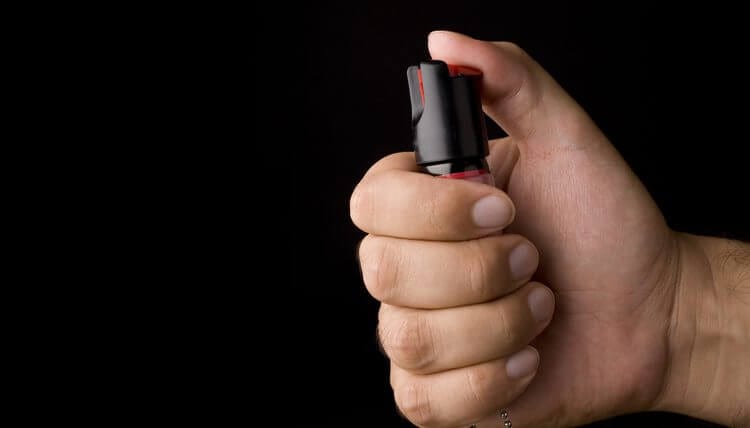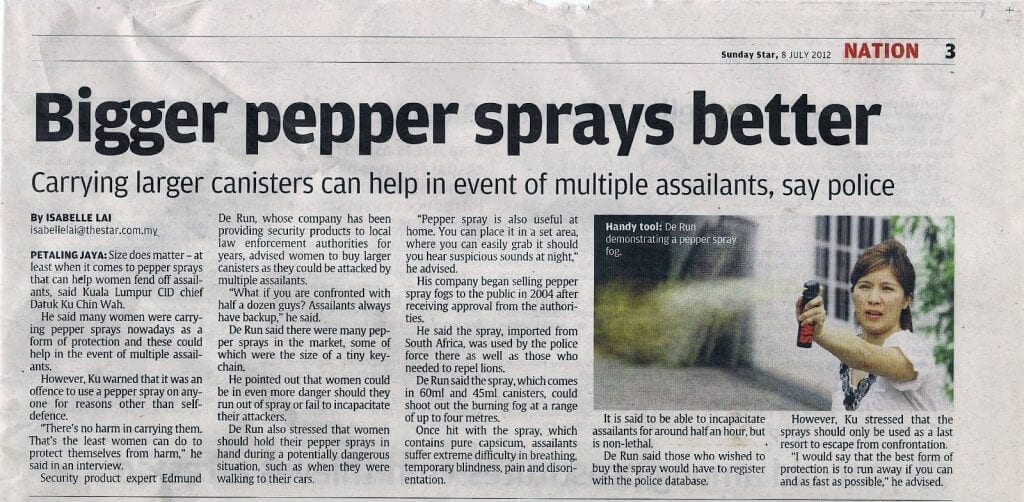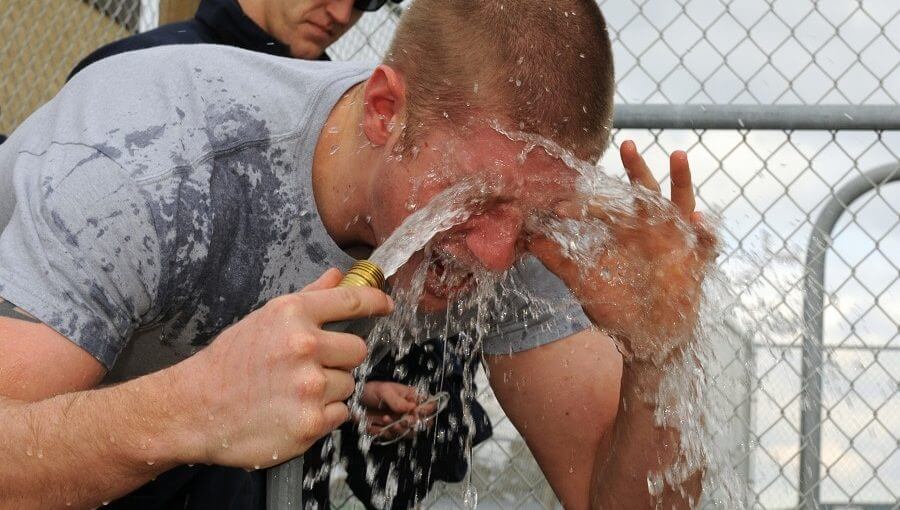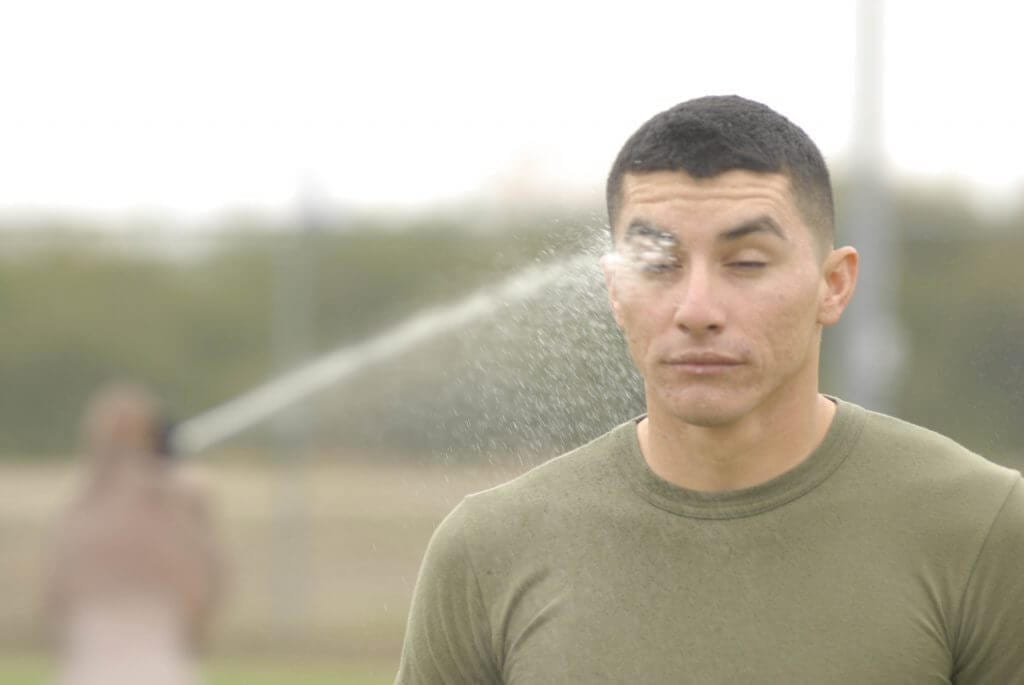Pepper spray safety is a crucial element of this common weapon. The spray is a popular self-defense solution that’s been around since the 1990s. It’s cheap, simple, and able to stun and blind enemies in an instant. Just like other weapons and self-defense tools, pepper spray comes with pros and cons.
Whether you’re thinking about a tactical scenario, crisis survival, or feeling safer when walking home at night, this non-lethal chemical spray can give you the safety advantage you need. It will make a nice addition to your arsenal or give you that extra edge you need when your self-defense skills aren’t quite enough on their own.
Before you buy anything, though, you should learn more about pepper spray and how to use it the right way. This article will teach you all you need to know about pepper spray, how to use it, how it’s regulated, and proper pepper spray safety.
General Pepper Spray Safety Precautions
Before getting in-depth with anything, it’s best to get an overview of basic pepper spray safety.
- Always keep the canister out of the reach of children and pets
- Always keep canisters away from extreme heat and cold, don’t leave them in your car
- Read the label to learn the specifics such as concentration level and shelf life
- Don’t try to use an expired can of pepper spray, buy new cans instead
- Shake cans of pepper spray on a regular basis to keep the chemicals mixed and ensure effectiveness
- The spray won’t reach very far, and will be less effective the further you are from the target
- Different sprays have different capacities and effective ranges, getting familiar with the chosen spray is crucial
- Pepper spray is only effective if you aim for the face and make sure a sufficient dose hits the eyes and gets inhaled
- Pepper spray does not incapacitate assailants like electric control weapons do. Be prepared for struggling targets
- Respiratory issues and heart problems can make pepper spray very harmful or deadly
- Using pepper spray against an attacker introduces a risk of spraying yourself or others around you
That covers the basics, and it’s time to learn more about this popular self-defense weapon.
What is Pepper Spray?
The key active ingredient is something known as oleoresin capsicum. This is an extract of pepper, most often cayenne pepper. The same substance that make those peppers enhance the flavor of your food is responsible for the stopping power of pepper spray. There are risks and complications, but proper use and pepper spray safety will make it a powerful tool in your hands.
This oily substance is called Capsaicin. On its own, it has no real smell or taste, but the powerful reaction it triggers can be excruciating. Even in small amounts. The levels found in pepper spray are far higher than those of any pepper fruit. It’s a simple, natural compound and you can even make it yourself in a survival situation. This video explains how.
The spray also contains water and/or carrier oils, which help spread and potentiate the harsh mist. There’s also the gas that propels the spray, and other trace ingredients.
The pepper extract creates a burning and itching sensation when it makes contact with skin or other bodily tissues. It can cause watery eyes and runny noses by mere proximity, and a direct spray to the face will lead to extreme pain and temporary blindness.
This is what makes it an effective self-defense weapon. But it’s also risky if you don’t know proper pepper spray safety.
The higher the concentration, the greater the stopping power, but it also increases the risk.
Some types of pepper spray contain additives such as dye or foul-smelling chemicals. This provides the added effect of marking the attacker and making it hard for them to get away with the crime. Certain types have a UV dye that makes it easy to identify a perpetrator even when they think they’ve washed it off, since UV is invisible to the naked eye.
The Effects of Pepper Spray
While the main effect of pepper spray is bad irritation to the skin and eyes, there are more aspects to its painful stopping power.
The harsh oil upsets the respiratory system, often constricting the trachea, which triggers coughing and makes it hard to breathe. This may cause panic, disorientation, and loss of physical strength.
As the burning mist gets into the sinus cavity, it triggers inflammation and increased mucus production. This makes it even more difficult to breathe. A person contaminated by pepper spray will cough, gag, and wheeze as they stumble around or fall to the ground.
Capsaicin is a very inflammatory substance and forces capillaries to dilate. This causes swelling and twitching. The effect is most notable on the eyes. Even with closed eyes, pepper spray that hits the face can cause involuntary spasms in the eyes and eyelids. As you can see, pepper spray safety is important.
Image via Midwayusa.com
The well-known tearing effect is the body’s attempt to wash the burning chemical out of the eyes.
If the sprayed person’s pores are already dilated due to physical activity or a hot climate, the burning skin sensation is even more intense. The spray can may cause discoloration of the skin, making it red or orange. The initial effect lasts around 30-60 minutes, but the substance will linger on the skin and in clothing much longer.
Varied Results with Pepper Spray
Pepper spray doesn’t work against everyone. And, like chemical agents in general, the effects differ between individuals and occasions.
Carrying spray does not guarantee safety or a quick way out of a fight. It doesn’t even guarantee pepper spray safety. There’s a well-known story from the 1990s where a police officer died after expecting too much of the spray. Contrary to what the manufacturers said, it couldn’t stop everyone.
When dispatched on a domestic abuse call, the officer came face to face with the violent criminal. The officer sprayed the criminal multiple times with his can of pepper spray, but to no avail.
Taken by surprise as the spray didn’t work as intended, the officer was wide open to attack. The violent man grabbed him and then beat him to death. This officer died clutching his canister of pepper spray.
It’s worth repeating, simply carrying a pepper spray can does not guarantee protection. Especially not if you don’t know proper pepper spray safety.
The first rule of self-defense is to stay out of danger. Only when danger is unavoidable is it time to reach for a self-defense weapon. And pepper spray will only save you if you use it right. You don’t want to end up suffering from your own spray.
Is Pepper Spray Legal?
While pepper spray is legal in all 50 states, the regulation differs in a number of ways. Some types of spray are banned in certain states, but not in others. Finding a canister for sale doesn’t always mean it’s legal, it’s important to read up on the regulations before you start looking for the product.
What sets aside different kinds of spray is the concentration of the capsaicin, other ingredients, and how the spray mechanism works. The typical pepper spray features a fogger which disperses the spray into a fine mist that spreads out over the target. Certain canisters produce a more focused stream of liquid instead. Types of pepper spray with coloring additives, such as UV dye, are illegal in certain states.
It’s best to check with your local police to learn the specific rules in your region.
Pepper Spray Safety and History
While many consider pepper spray a modern alternative to firearms for self defense, the chemical concoction has a long history. The oldest record of Oleoresin Capsicum use is from 311 BC, when the Chinese boiled red peppers in oil and used the inflammatory stew against their enemies.
The Greeks also used a version of OC in 673 AD. This mixture, known as Greek fire, contained peppers, sulfur, and quick lime. In 1200 AD, European armies started firing large amounts of the inflammatory liquid with catapults. OC also played a role in the American civil war.
The first spray containing OC appeared in 1973, as a tool for defense against aggressive dogs. In the 1990s, law enforcement agencies started replacing their Mace cans with pepper spray. Around the same time, it gained popularity as a personal protection weapon.
Ever since the ‘70s, various sprays have acted as self-defense tools for women in particular. While many different kinds have appeared on the market, pepper spray has had a much steadier popularity than other kinds. This has made pepper spray safety a necessary and hot topic.
Pepper Spray vs. Mace and Tear Gas
Many people believe that Mace and pepper spray are the same thing, but this is not the case. Chemical mace, also known as phenacyl chloride or CN, is a chemical weapon developed in the ‘60s. It’s an irritant with effects similar to those of tear gas (orthochlorobenzalmalononitrile, or CS for short.)
To make it more confusing, the trademarked brand name Mace is now a manufacturer of pepper spray and tear gas.
All three products have similar effects, such as breathing problems, pain, and watery eyes. However, they achieve this in different ways. Tear gas and Mace are irritants, while pepper spray is an inflammatory agent. Mace and tear gas do not work against targets under the influence of drugs or alcohol, but pepper spray does.
This is why law enforcement agencies stopped using mace and started using pepper spray instead. Unlike the fleeting chemical gas, oily pepper spray sticks to the target and it’s hard to wash off. This creates a more long-lasting discomfort. On the other hand, tear gas lingers in clothes, unlike pepper spray.
In some states, there are sself-defensespray products that combine pepper spray with teargas or mace. However, tear gas is only available to the police in most places.
Buying Pepper Spray
You can find pepper sprays in a variety of stores. You can buy them online or in physical locations. The most important quality to look for is the product’s concentration level. It must be strong, but it must not exceed the legal limit. Anything above it is police grade pepper spray and inappropriate for civilian use.
While getting a higher grade for a potential crisis may sound like a good idea, staying on the safe side of the law is an important part of pepper spray safety.
Some states only let you buy from specific stores, and you may only be able to get your hand on a weaker spray intended for use against aggressive animals. When it comes to concentration, the limit is 10% OC for civilian grade pepper spray in most places. There may also be a maximum legal size.
For example, Wisconsin allows up to 60 grams with a concentration of 10% or less, while Michigan only allows 35 grams. In certain places, such as Washington D.C., the law requires you to register your pepper spray with law enforcement.
Learn what’s legal where you live before you go shopping.
Image via Wallpaperama.com
Police-Grade Pepper Spray Safety
The police can use much stronger pepper spray, due to job requirements and the fact that they receive training on proper and safe pepper spray use. Civilians don’t need training to be allowed to use pepper spray in states where it’s legal.
Due to this fact, using a product that’s stronger than the legal limit is more dangerous than most would think. Police grade pepper spray can be three times as strong as civilian options. That’s about 1,000 times the strength of jalapeño peppers.
Another key difference is the spraying mechanism. Civilian spray only comes in spray canisters that produce a mist of the inflammatory oil, with very few exceptions. The spread this provides makes it easier to hit a target in general, but it also increases the risk of contamination. It also makes it hard to use in windy conditions.
The police have another option, where the oil is in a foamy state and sprays in a fine stream instead of scattering mist. This makes it very precise and efficient, delivering a more concentrated dose of the already much stronger chemicals. It won’t lose potency on its way toward the target, like ordinary spray does. And there’s little to no risk of cross contamination.
Since vendors don’t always know (or care about) the laws surrounding specific products, you may find these police grade products for sale sometimes, especially online. It’s important to be careful so you don’t buy an illegal product thinking it’s legal.
Police grade pepper spray is dangerous and merit the strict regulations. Many people have died after being pepper sprayed. While the spray isn’t deadly to the average person, aggravated causes can worsen its effects. Asthma, allergy, and heart conditions are a few common examples.
Why Carry Pepper Spray?
Some readers may be wondering what’s so great about pepper spray after all these warnings and things to keep in mind. The fact of the matter is that it’s still an effective self-defense weapon and popular for a reason. In a tactical scenario, it may provide you with the non-deadly force you need to stop a dangerous subject. In daily life, it will help protect you from a variety of shady people as well as wild animals.
Carrying something that can help you ward off or incapacitate an attacker is crucial to your survival and security. Especially if you’re a woman. The mere knowledge that you have something dangerous on you can make you feel much better and help scare away attackers. Attackers go for targets who look easy to overpower. If you have a visible weapon or make a very confident impression, they’ll think twice about attacking. If you look scared and unarmed, you’re a prime target.
The fear of being victimized can be crippling, especially to those who’ve experienced it before. This constant background fear can have a lot of negative effects on your life, and you may not even realize it’s there until you arm and train yourself and lose the fear.
In 2016, there were more than 3.5 million reported victims of violent crime in the United States. In rough numbers, 15 out of every 1000 people will be the victim of violent crime in their lifetimes.
In a group of 100, one or two will experience a violent attack on average. It could be you or someone close to you. If you want to be prepared for a crisis, keep in mind that these odds are nothing compared to what you would face if society collapsed.
How to Use Pepper Spray and Ensure Pepper Spray Safety
It’s important to use pepper spray the right way. With proper safe use, you’ll see the best results and eliminate the risk of accidents. If you end up in a situation where you need to use your spray, you’ll need effective results. And any risk of accidentally causing more danger or pain to yourself is unacceptable.
Carrying and Storing the Spray
First things first, how to carry the spray. Keeping a canister in a bag isn’t ideal, because it can take too long to take it out and use it. In a tactical situation or crisis, the spray should go on your tactical belt. This doesn’t work in civil settings, but there are other options. For example, many pepper spray canisters can attach to your key ring. This makes it easier for you to pull it out fast, and harder for the attacker to predict.
Most canisters have a reliable safety device that prevents accidental spraying while you carry the spray. Easy carrying and storage are important parts of the design, and you can count on the safety in general. All you need to concern yourself with is where the safety mechanism is and how to disengage it and reset it the proper way.
When you’re walking somewhere and you don’t feel safe, it’s best to get the spray ready. Disengage the safety and keep the spray ready in your hand so you can use it in a split second is something were to happen.
Image via Legalbeagle.com
Always remember to put the safety back in place before you put the spray away. Otherwise, you risk a very unpleasant experience, and you may waste the spray without knowing it. This could lead to a very bad scenario where you think you’re prepared but you’re really not, and you’re powerless to stop your attacker.
Safely Using Pepper Spray
Getting familiar with your spray before relying on it is crucial. First, check the trigger. You find this either on top or on the front. Practice wielding it to find the best grip that lets you reach and squeeze the trigger without losing your aim.
When you’re in a potentially dangerous situation, keep your spray in your hand. Not in your pocket. It’s best to carry the spray canister at your side, and you should always keep your finger ready on the trigger. If someone attacks you, every fraction of a second counts. Always be ready to use your self-defense weapon on a moment’s notice.
Follow these steps for proper pepper spray use:
- When a threat approaches, raise your arm to face level.
- As soon as they’re within range and the can is level with their face, press the trigger. You don’t have time for proper aiming in the typical situation, and you don’t need it since the spray is designed to spread.
- Press the trigger all the way and move your hand in a small circle or zigzag motion to increase your chances of hitting a moving face. The steady stream of OC will burn and blind the attacker in an instant. Even if they’re numb or immune to pain, the blindness and breathing difficulty will stun them and let you escape the threat.
A good spray will work from several feet away, but this depends on the situation. The further away the target is, the less concentrated the spray will be on contact. It may not have much stopping power. Wind, rain, and air pressure also affect how well the spray travels.
Image via Science.howstuffworks.com
Since the stinging oil comes out as a mist, it spreads in every direction from the canister. This means there’s a risk that you could end up with pepper spray on your own face as well. Prepare yourself for this. Try to avoid the spray and make sure that you know how to escape even if you can’t see.
This video can help you get a better idea of how to use pepper spray safely:
How to Use Stealth Pepper Spray
Self-defense weapon manufacturers have gotten creative and there are now a wide selection of clever, inconspicuous designs for stealthy use. These can have many civilian and tactical uses, from letting you overpower a kidnapper to helping you advance in enemy territory like James Bond.
These stealthy pepper spray safety gadgets often masquerade as flashlights, phones, pens, lipstick, and various other harmless everyday items. And they do it quite well. The design of such a product may limit its range and capacity, and make it a little more difficult to use. Regardless, having one for those scenarios can save your life.
The most important thing to think of when using pepper spray of this type is to produce the device in a natural manner. If it becomes obvious that you’re about to use a self-defense weapon, your assailant is likely to render your efforts futile. Practice taking the device out and aiming in an efficient manner so you’re ready if it ever becomes necessary. Also, practice disengaging and resetting the pepper spray safety mechanism.
Pepper Spray Range and Capacity
How far you can spray the inflammatory oil depends on the canister’s size and pressure level, and on the delivery mechanism. The typical spray has a maximum effective range of four to fifteen feet. While the former is a bit short, the long range of the latter has few practical uses unless you’re very good with the spray. Hitting the face of a moving target at that distance can be a real challenge.
It’s best to avoid either extreme and spray when the assailant is around six feet away. However, having a longer maximum range is still a good advantage.
The smaller cans that belong on key chains don’t tend to reach further than five or six feet. You’ll only get one or two bursts of spray out of a key chain pepper spray can, maybe three. The convenience of this type of pepper spray makes it a worthy trade-off for civil scenarios. When it comes to tactical situations, you need something bigger and better.
Image via SGpepperspray.blogspot.com
Larger canisters spray more, further, and wider. You can hit a target from 12 feet with ease unless the wind conditions are bad. And you’ll be able to fire multiple times. If you spray in two-three second bursts, you can use it five or six times before running out of spray.
Note that older canisters will have a lower pressure which results in decreased spray duration and effective range.
Stopping Power
For the spray to have a big impact on your assailant, it must make contact with his face in a sufficient concentration. It’s when the inflammatory spray gets inside the eyes, mouth, and sinus cavity that it becomes effective. If the aim is off, or the target is outside the effective range, or the wind interfered, it may not be enough to stun the attacker.
Keep in mind that pepper spray does not incapacitate people under normal conditions. It’s meant for stunning and blinding in order to escape or subdue the target. A small amount of spray may not be enough, and may enrage the assailant further. This is why it’s important to spray a good burst of peppery mist in the target’s face.
When using a small can of pepper spray, it’s important to take aim and keep the trigger down to ensure plenty of pepper spray gets in the attacker’s eyes.
Small and medium cans are good for protecting yourself while walking or exercising. In tactical scenarios, you want the big cans of pepper spray that let you deal with multiple targets and keep spraying. These options may not be ideal for everyday self-defense though, since they’re harder to carry and store and may be illegal.
Dealing with Old Cans of Pepper Spray
Pressure dissipation will make your pepper spray canisters lose power over time. As the pressure fades, the range decreases, and so does the number of rounds you can spray. The shelf life for a typical can is around four years, but it varies between types and manufacturers.
Returning a pepper spray can after purchase is unlikely to work due to the chemical materials. And it should go without saying that selling or buying them second-hand or dealing with questionable peddlers is a bad idea that will only introduce various risks.
While the propellant gas dissipates, the Oleoresin Capsicum remains. Old canisters aren’t harmless. In a crisis or survivalist scenario, you may use this to your advantage and reuse the OC in other ways.
Any expired or used-up canisters you accumulate are considered hazardous waste, and you should deal with them accordingly.
Testing and Training with Pepper Spray
The advantages you’ll gain from pepper spray depend on how well you use it. Knowing the theory is one thing, actually doing it all the proper way in the heat of a stressful scenario is a different story. If you come unprepared for the situation, not knowing what to do or whether the can works, you’re unlikely to defend yourself.
It’s also worth noting that hardened criminals may know how to counter or disarm their victims if they see pepper spray. And, for women in particular, attackers are often someone close to the victim. This person knows the victim’s weaknesses and what means of self-defense they may have.
Pepper spray alone does not incapacitate a victim like a Taser does. All it does is blind and stun the target and cause intense pain. To get the best effect, you must know proper use of pepper spray and some basic self-defense moves.
Practice Proper Use with Pepper Spray Safety
The easiest way to get familiar with pepper spray safety is to train with a practice canister. These have the same general design as a real can of pepper spray, but only contain water or another harmless liquid. This lets you practice spraying without any risk to you or other people.
Rehearse your response to threats, arm and aim the can over and over until it comes naturally. You need this in order to be prepared in case of emergency, fumbling and hesitation are unacceptable.
It’s best to keep a slight bend in your arm. If your arm is straight, it’s easy for your assailant to disarm you. Also, think of your grip. If the trigger is on top of the can, use your thumb to press it. This makes the grip more stable and makes it hard to yank the canister from your hand.
It’s a good idea to practice with a friend if you have a practice canister. This way, you learn how to aim at a moving target and avoid attacks. Remember to spray back and forth to cover a bigger area.
Practice the follow-up and escape as well. Always dodge to the side to avoid the blinded attacker. Then make your escape. If that’s not possible, incapacitate the assailant with a kick and then run.
Getting familiar and comfortable with the proper use of the product and pepper spray safety, in general, will make you ready for the worst.
Pepper Spray Contamination
When you use pepper spray, there’s a risk that the spray can get on you or other people around you. The oily substance doesn’t discern between bad guys and good people. They fly wherever the laws of physics lead them. Be prepared for an unintentional spread, especially when you spray indoors or in another enclosed space.
For this reason, refrain from using pepper spray in crowds and scenarios where teammates or bystanders are in close proximity to you and the attacker.
If you spray yourself or a bystander, it’s important to try to get fresh air as soon as possible.
If you sprayed in an enclosed space, such as a room, you’ll have to air it out with fans before it’s safe to enter again. The oil can linger for a long time.
Treating Pepper Spray Burns
If you get spray on your face or other parts of your body, it can hurt for a very long time. The initial burn should dissipate after a half hour to an hour. However, there will be a lingering burning sensation for a day or two.
Image via Selfdefensehero.com
Treating the symptoms of pepper spray contamination consists of two tasks, removing the oil and soothing the irritated tissue.
The first thing to do after getting sprayed is getting out into the fresh, cool air if possible. Avoid touching your face at all costs, or you’ll spread the oil a lot. Blink a lot to help flush out any capsaicin that’s gotten in your eyes.
Then seek out clean water and soap. You need a strong soap, like the kind used for washing up dishes. Baby shampoo is another good option. It’s important to note that this may intensify the burn at first, and will spread the oil to other parts of your body if you’re not careful. Cold water is the most effective since it closes the pores, and also helps soothe the pain.
Once you’ve washed most of the oil off yourself, it’s nice to put something soothing on the burn. Milk and yogurt are popular options that help neutralize the burn and heal the skin. Avoid skin products, as the chemicals and oils will interact with the OC. Don’t try to put ice on the afflicted area, it won’t help. These are the first basic tenets of pepper spray safety.
How an Assailant’s Condition Affects Pepper Spray Effect
The effect of pepper spray (and thus the need for pepper spray safety) varies between individuals and situations. Pain tolerance is an important matter, and there are many factors that play into this equation. How the spray affects a calm, sober person doesn’t always represent how it would affect an angry, drunk person.
Imagine the state of mind of a potential assailant. Think of the focus, motivation, determination, and energy level. If you’ve been in a state of really high adrenaline, you know how it affects your pain tolerance and general perception of the world. While the spray will blind and confuse a violent criminal or animal, it won’t stop them from charging you. This is why being prepared to dodge or follow up with a finishing blow is so important.
Alcohol and drugs that affect physical and mental states of being tend to make a person less reactive to pepper spray as well. There are also theories that individuals who eat a lot of cayenne pepper may have a tolerance to pepper spray.
Rage, commitment, and desperation can all dampen a person’s pain response and let them remain violent. Law enforcement agencies train their officers to follow up with batons or submission holds after spraying a subject.
It’s rare that a sprayed person falls to the ground like you may have seen on the news or in YouTube videos. Pepper spray doesn’t incapacitate people under normal circumstances. A calm, unsuspecting, or cowering person may have a very strong reaction to pepper spray. This is because their guard is down.
Dealing with the Situation
A furious or deluded attacker may have a very minimal reaction to chemical self-defense sprays. This is why it’s crucial that you aim for the eyes. The blinding effect is more reliable, and so is the respiratory effect. You can’t rely on pain compliance or incapacitation.
Some individuals have little to no sensitivity to pain, and no matter how strong your spray is, it won’t stun them. But nobody is immune to the effect it has on eyes and the respiratory system. This is why proper aiming matters so much.
Image via MCRC.marines.mil
Being aware of these facts will help you in a few different ways. First of all, you’re more prepared and know what to expect or not expect. You can also use this to your advantage if you’re sprayed. Resist and push through the pain, and you can get the momentum you need to make your escape without harm.
The risks of improper pepper spray safety aren’t a problem when you know how to handle it. There is no quick fix to personal safety and self-defense, every weapon has its flaws and conditions. Knowing how to use things the right way and how to flee and fight is more important than the specific products you use.
Conclusion
This spray is an effective tool for protecting yourself and people around you, but pepper spray safety is of the utmost importance. This product will blind and stun attackers in a few different ways.
The instructions and advice found throughout this article will help you use pepper spray in the safest and most effective way. But theory is no good unless you practice. You must get familiar with wielding pepper spray in order to be prepared.
Despite its complicated nature, it’s a good self-defense weapon because it’s cheap and easy to use. The risks associated with pepper spray are minimal, and it’s safe to own even if you have children.
It’s a non-lethal option that can save your life if you know how to use it.

